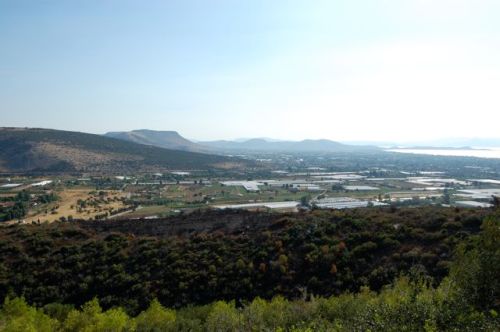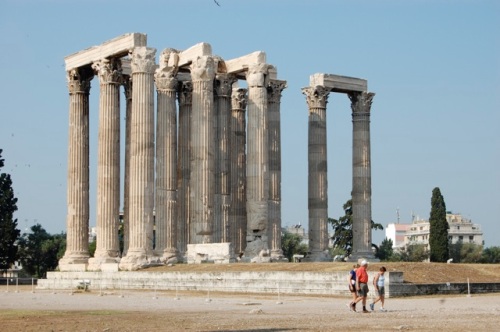What do we see when we go to a museum? What are we looking for?
After touring the site of the original Olympic games, I sat down in front of a famous sculpture depicting Hermes and the baby Dionysus, carved by the artist Praxiteles. The following are my musings from that moment.
On the statue.
Alone in a room dedicated to this sculpture, Hermes pauses to rest. He is nude, his cloak thrown over a tree. The baby wine-god Dionysus seems to reach, perhaps (a guidebook suggests) for a bunch of grapes Hermes holds with an arm now lost.
(According to the myth told by Apollodorus (3.4), Dionysus was the son of Zeus by the mortal woman Semele. Angered at one of her husband’s many affairs, Hera caused Semele to doubt the divine parentage of her pregnancy. Despite his misgivings about his lover’s insistent request, Zeus appeared to Semele in all his glory, which resulted in her fiery death. Zeus rescued the six-month unborn Dionysus and stitched him into his own thigh. After Zeus gave birth to “twice-born” Dionysus, Hermes brought the infant to be raised by the nymphs who dwelt at Nysa in Asia, hence the name Dio-Nysia, the god of Nysa.)
Hermes’s face is peaceful and serene, looking not at Dionysus but off into the distance, slightly downward, composed and calm. The white Parian marble shines with an intense luminosity, and seems to emanate its own light, though it but reflects the spotlights from above. The S-shaped curve of his body suggests potential energy, as do the taut musculature and powerful pose. Even though the god rests against a tree, his upraised left heel suggest that he is ready to move at a moment’s notice.
The missing pieces from Hermes’s outstretched right arm and both Dionysus’s arms remind us that our knowledge of the past will remain forever fragmentary and incomplete. Though we may make new discoveries, the inexorable forward movement of time creates ever increasing distance between us and the past.
The self-possessed composure of the god’s aspect is reminiscent of Apollonian sophrosyne, the idea of self-control so praised by philosophers—to be at peace with one’s self, to be in harmony with the world, to be master of one’s own emotions and actions, if not one’s destiny, to change what one can and to accept gracefully what one cannot. These are also the reasons why the Roman emperor Augustus later styled his own public image in the form of such gods (typically Apollo, though this Hermes has similar poise), to project power and control, as well as divine destiny.
On taking photographs in the museum.
We worship what we think is good. The streams of tourists who come into this room, admiring the statue, examining it, videorecording it or snapping photographs, are all practicing some form of veneration. Little of this attention nowadays can be understood as venerating the god himself. We modern viewers might venerate the skills of the artist Praxiteles. We might admire it out of our own accord as well as out of a sense that we should. “This is really famous, isn’t it?” asks a teenaged girl with her parents. Later, a tour guide tells his group, “This is a very important statue.” Are so many people coming to look at it because it is famous and important, or is it famous and important because so many people come to look at it?
Despite our different reasons for coming to see, we all pause long enough at the well to satisfy our thirst. Some enter the room, snap a photo, turn and leave in a matter of seconds. Others walk around the perimeter and see from different angles, videorecorder in hand. A timid young girl, perhaps six or seven years old, wearing a pink cloche hat seems to be awkwardly interested more in the other people in the room, at times clinging to her mother, at times wandering and looking at the marble floor tiles, at the scruffy-bearded man, at everything but Praxiteles’s statue. Some people get chastised by the guard for posing with the antiquities; others get away with it. “No flash please,” is her refrain. (Must be a boring job, and despite being in the same room as the statue every day I wonder how often she looks at it rather than at its sycophants.) Day in and day out, people from around the world pour into this room, some on their own, some with families or friends, some in larger guided groups. Still stands the god, on his pedestal, separated from the worshippers by a dry moat and a low railing, within a designated room, under constant illumination and surveillance by security cameras and a modern-day priestess charged with guarding his cult image.
On leaving.
“You cannot stay on the summit forever; you have to come down again. So why bother in the first place? Just this: What is above knows what is below, but what is below does not know what is above. One climbs, one sees. One descends, one sees no longer, but one has seen. There is an art of conducting oneself in the lower regions by the memory of what one saw higher up. When one can no longer see, one can at least still know.” — René Daumal
Just as with the mountain, so also with the man-made masterpiece: for those who stay for a moment and for those who stay hours or longer, at some point the time comes when each of us must leave. We take with us our thoughts, emotions, memories, photographs. We depart changed by the experience—or more likely not. Perhaps we have learned something—the shine of Parian marble, the severity of a guard’s yell, the rough-hewn backside of a front-facing statue, the curiosity of a child for things other than what she was told to pay attention to. Perhaps we will look often at our poster, our drawing, our notes, our postcard, but more likely the memory will fade and the images (poor imitative replicas that they are) will gather dust and become buried in the silt of obscurity that buried this statue for so long. It is good, then, that such places as this exist, both as a storeroom of objects that are famous and important and as a museion, a temple of the muses, a shrine to come for inspiration, for a break from the hot sun, for a chance to pause and reflect.























































